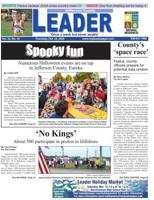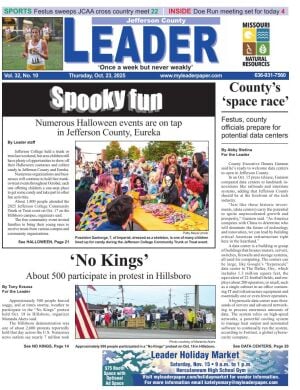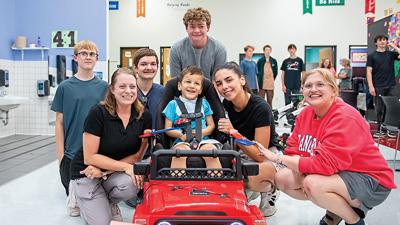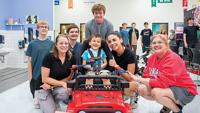Members of Fox High School’s robotics team recently saw their work pay off.
The squad adapted a battery-operated toy vehicle commonly called a Power Wheel and took it to the Don Earl Early Childhood Center this month for two students with mobility limitations to test drive.
The robotics team had worked since January to rewire the toy vehicle and add special features, like a car seat, movable arms to hold the power switch and an emergency shutoff button on the front bumper.
Then, on Oct. 3, the high school students watched the joy the two students from the early childhood center experienced while driving the vehicle.
“I thought it was amazing,” said sophomore Landin Wozniak, 15, of Arnold, who worked on the project, along with juniors Lakoda Stoutt and Carter Bunn. “They were happy.”
Adin Zukanovic, 4, and his brother, Armin, 3, both of Arnold, were the first young students to drive the modified vehicle, which is modeled after a Toyota SUV.
Temeida Mahmutovic, the boys’ mother, said her sons have cerebral palsy, a group of neurological disorders that affect movement and posture, according to the Mayo Clinic website.
She said it was amazing to see Adin, who walks with the assistance of a modified walker, and Armin, who is bound to a stroller, drive a battery-operated toy vehicle on their own.
“It was pure joy,” Mahmutovic said. “I think it is simple for them to use with the touch of a button. I feel like they were able to grasp it quickly and understand how to use it.”
Matt Freeman, a Fox High science teacher and the robotics team supervisor, said it was important for the robotics team members to see their work in action.
“When Armin’s face lit up when he could control it on his own, that was fantastic,” Freeman said. “I was excited to see it, and I looked over at the kids and saw the pride in their eyes for their work.
“There was a lot of boring work, like how they were going to get the car seat mounted in so it was safe. That (required) multiple meetings of planning and work. The test drives were the payoff; that is fantastic.”
The project
Jennifer Bullock-Wells, a physical therapist assistant at the early childhood center and Simpson Elementary School, said she reached out to Freeman to ask if his robotics team could make the modified battery-powered vehicle.
She said she learned about the vehicles while attending St. Louis Community College and was introduced to the “Go Baby Go” mobility program. The national program began in 2012 at the University of Delaware, according to health.oregonstate.edu.
“Last year, when I was working with a lot of the kids with physical impairments, I thought it would be a great opportunity to bring this car in to teach them how to use a switch,” said Bullock-Wells, who began working for the Fox C-6 School District last school year. “We can change the switch button with a joystick, so I can train a child to use a motorized wheelchair in the future.”
Freeman said he knew the students would be excited about the project after talking with Bullock-Wells.
“My initial concern was what are the ways we could make it applicable to as many kids as possible,” he said. “We didn’t just build it for one kid.
“I also wanted to integrate it into something that our newest club members could do. My seniors could have built it from scratch, but the three guys who took this on, they had just joined last year. They were fresh on the team. They took it on and were willing to ask questions and learn. The rest of the team did help with individual components and problem solving. That is what robotics is about; if there is a problem how are you going to solve it?”
Freeman said the Early Childhood program purchased the vehicle for about $200, and the robotics team spent about $100 on parts and components.
“I thought it was interesting,” said Bunn, 17, of Arnold. “I saw it as an opportunity to understand how robotics works because (battery-operated vehicles) are similar to robots. I thought it could help some kids and help me get some knowledge of robotics.”
Bunn said figuring out how to rewire the vehicle was the most challenging part of the project. He said parts of the vehicle were removed and reconfigured to allow a child with disabilities to use it.
“We wanted to make something they could use without struggling,” said Stoutt, 16, who lives in the Jefferson County portion of Fenton. “It was challenging. Not every kid is the same, so it is challenging to figure out where to put some things and the size of the seat.”
Kayla Kirchoff, Adin and Armin’s teacher, said the robotics team did an incredible job building the modified vehicle.
“It kind of shows what they are doing matters and changes lives,” she said. “I think it is really exciting, and I hope it inspires them to keep creating.”
Robert Townsley, the early childhood director, said he was impressed with the project and enjoys seeing the district’s different schools work together.
“We are always looking for partnerships,” he said. “We have the Special Olympics program with the Student Council. We have done other things with Ridgewood Middle School. Any time something like this presents itself we are excited.
“The impact is we are individually helping lives, and we are also drawing the community closer. We want to model good citizenship from 3 year olds all the way up. It reminds us of why we are here.”
Freeman said the robotics team plans to make two versions of the modified vehicle for the early childhood center.
The one the Zukanovic brothers used on Oct. 3 only had a button to make the vehicle go, and someone else had to move a lever on the dashboard up or down to make it go forward or backward. The other vehicle will have a control stick on the arm in place of the button, which will allow a child to not only make the vehicle move forward or backward, but also maneuver it to the left or right.
Freeman said the test drives will likely motivate the robotics team members.
“Seeing the children use it up here, I guarantee I will have four or five kids who will want to do this project,” he said.
Test drives
Armin went first after his older brother was hesitant to get into the modified vehicle.
At first, the 3-year-old boy struggled to hold down the big red button that makes the vehicle go, and an Early Childhood staff member helped him hold it down. But, after getting the vehicle to move, he learned to hold down the button himself, and he smiled as he drove the vehicle around.
Adin got in after his brother, and after a little help, he, too, got the hang of driving it. He smiled and let out squeals of joy while driving the vehicle.
“It was quite special,” Bullock-Wells said. “I had never seen Adin that happy before. That was really cool to see.”
Benefits
Mahmutovic said her family has a traditional battery-powered vehicle at home, but her sons are not able to push down the gas pedal and steer at the same time. She said she is happy the early childhood center now has a vehicle they can operate themselves, adding that when a control stick is added, the boys may use it to prepare for operating a motorized wheelchair in the future.
“They most likely will need a wheelchair in the future,” Mahmutovic said. “This is a great way to get around, and a lot more fun. I feel like as a kid I would rather get into that than a wheelchair. I think it will motivate kids.”
Bullock-Wells said she has five or six students who will likely use the modified vehicle. She said she hopes the robotics team will also make a vehicle for Simpson Elementary.
“It is a good transition to a motorized chair,” she said. “By adapting the battery-powered car, it gives the child the ability to operate it independently. It also improves their cognitive, social and motor functions.”
Kirchoff said along with having a new tool to help students develop their skills, the project also showed the robotics team members the importance of Fox C-6 schools assisting each other.
“It is easy to kind of get wrapped up in your own bubble,” she said. “Remembering we are a community and are here to help each other, I think that is the best part.”




